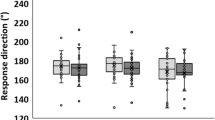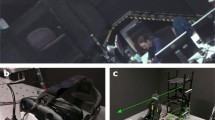Abstract
Our perception of the vertical depends on allocentric information about the visual surrounds, egocentric information about the own body axis and gravicentric information about the pull of gravity. Previous work has documented that some individuals rely strongly on allocentric information, while others do not, and the present work scrutinizes the existence of yet another dichotomy: We hypothesize that in the absence of allocentric cues, some individuals rely strongly on gravicentric information, while others do not. Twenty-four participants were tested at three angles of body pitch (0° = upright, −90° = supine, −110° = head down) after eliminating visual orientation cues. When asked to adjust a rotating tree ‘…such that the tree looks right,’ nine persons set the tree consistently parallel to gravity, eight consistently parallel to their longitudinal axis and seven switched between these two references; responses mid-between gravity and body axis were rare. The outcome was similar when tactile cues were masked by body vibration, as well as when participants were asked to adjust the tree ‘… such that leaves are at the top and roots are at the bottom’; the incidence of gravicentric responses increased with the instruction to set the tree ‘… such that leaves are at the top and roots are at the bottom in space, irrespective of your own position.’ We conclude that the perceived vertical can be anchored in gravicentric or in egocentric space, depending on instructions and individual preference.


Similar content being viewed by others
Notes
It is well established that vibration effectively masks natural tactile signals (e.g., Ribot-Ciscar et al. 1989).
References
Aubert H (1861) Eine scheinbare bedeutende Drehung von Objecten bei Neigung des Kopfes nach rechts oder links. Virchows Arch A 20:381–393. doi:10.1007/BF02355256
Betts GA, Curthoys IS (1998) Visually perceived vertical and visually perceived horizontal are not orthogonal. Vision Res 38:1989–1999. doi:10.1016/S0042-6989(97)00401-X
Brady RA, Peters BT, Batson CD, Ploutz-Snyder R, Mulavara AP, Bloomberg JJ (2012) Gait adaptability training is affected by visual dependency. Exp Brain Res 220:1–9. doi:10.1007/s00221-012-3109-5
Buneo CA, Jarvis MR, Batista AP, Andersen RA (2002) Direct visuomotor transformations for reaching. Nature 416:632–636. doi:10.1038/416632a
Darling WG, Hondzinski JM (1999) Kinesthetic perceptions of earth- and body-fixed axes. Exp Brain Res 126:417–430. doi:10.1007/s002210050748
de Winkel KN, Clément G, Groen EL, Werkhoven PJ (2012) The perception of verticality in lunar and Martian gravity conditions. Neurosci Lett 529:7–11. doi:10.1016/j.neulet.2012.09.026
Dyde R, Jenkin M, Harris L (2006) The subjective visual vertical and the perceptual upright. Exp Brain Res 173:612–622. doi:10.1007/s00221-006-0405-y
Ebenholtz SM (1970) Perception of the vertical with body tilt in the median plane. J Exp Psychol 83:1–6. doi:10.1037/h0028518
Hodgson CI, Christian E, McMorris T (2010) Performance on the portable rod and frame test predicts variation in learning the kayak roll. Percept Motor Skills 110:479–487. doi:10.2466/pms.110.2.479-487
Isableu B, Ohlmann T, Cremieux J, Amblard B (1997) Selection of spatial frame of reference and postural control variability. Exp Brain Res 114:584–589. doi:10.1007/PL00005667
Jenkin HL, Dyde RT, Zacher JE, Zikovitz DC, Jenkin Allison RS, Howard IP, Harris LR (2005) The relative role of visual and non-visual cues in determining the perceived direction of “up”: experiments in parabolic flight. Acta Astronaut 56:1025–1032. doi:10.1016/j.actaastro.2005.01.030
Kornilova LN (1997) Orientation illusions in spaceflight. J Vestibular Res 7:429–439. doi:10.1016/S0957-4271(96)00184-X
Mittelstaedt H (1983) A new solution to the problem of the subjective vertical. Naturwissenschaften 70(6):272–281. doi:10.1007/BF00404833
Müller GE (1916) Über das Aubertsche Phänomen. Z Sinnesphysiol 49:109–246
Prothero JD, Parker DE (2003) A Unified Approach to Presence and Motion Sickness. In: Hettinger L, Haas M (eds) Virtual and adaptive environments: applications, implications, and human performance issues. CRC Press, Boca Raton, pp 47–66. doi:10.1201/9781410608888.ch3
Ribot-Ciscar E, Vedel JP, Roll JP (1989) Vibration sensitivity of slowly and rapidly adapting cutaneous mechanoreceptors in the human foot and leg. Neurosci Lett 104(1–2):130–135
Witkin HA, Lewis HB, Hertzman M, Machover K, Meissner PB, Wapner S (1954) Personality through perception: an experimental and clinical study. Harper, Oxford
Wu W, Hatsopoulos N (2006) Evidence against a single coordinate system representation in the motor cortex. Exp Brain Res 175:197–210. doi:10.1007/s00221-006-0556-x
Zago M, La Scaleia B, Miller WL, Lacquaniti F (2011) Coherence of structural visual cues and pictorial gravity paves the way for interceptive actions. J Vis 11:13. doi:10.1167/11.10.13
Acknowledgments
The authors wish to thank following persons for their (technical) support: Hans-Martin Küsel-Feldker and Jürgen Geiermann for building the experimental rack; Malte Kraul for experimental preparation; Simon Engelke and Felix Bendig for data acquisition; and Thomas Kesnerus for software development. This work was supported by a Grant of the Centre for Human Integrative Physiology in Space (CHIPS), funded by the German Sport University Cologne.
Author information
Authors and Affiliations
Corresponding author
Rights and permissions
About this article
Cite this article
Bury, N., Bock, O. Role of gravitational versus egocentric cues for human spatial orientation. Exp Brain Res 234, 1013–1018 (2016). https://doi.org/10.1007/s00221-015-4526-z
Received:
Accepted:
Published:
Issue Date:
DOI: https://doi.org/10.1007/s00221-015-4526-z




